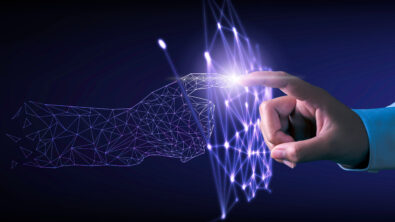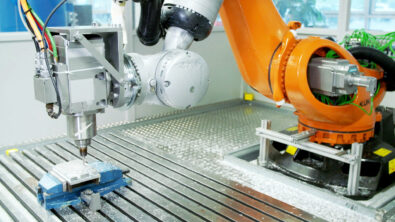Talking Aerospace Today – Authoritative Automation Part One – Transcript

The Talking Aerospace Today podcast moves onto the next phase of automation in digital transformation maturity: authoritative automation. Todd and Patty discuss what it entails and how it has already changed our lives outside of aerospace.
Listen to the full episode or continue reading below for the transcript.
Patty Russo: Greetings and welcome to another episode of Talking Aerospace Today from Siemens Digital Industries Software. I’m Patty Russo and I’m responsible for global marketing for aerospace and defense vertical here at Siemens. Thank you for joining our conversation today. With me again is our aerospace and defense VP Todd Tuttle. Welcome, Todd.
Todd Tuthill: Hey Patty, thank you. It’s great to be here again with all with you and all our listeners on this journey through digital transformation maturity.
Patty Russo: Speaking of which, why don’t we start this episode with a brief review of where we are as we explore digital transformation maturity?
Todd Tuthill: Sure. As we’ve said before, we talk about five steps, five places to digital transformation maturity. The first is configuration. The second is connection. The third is automation. The fourth is a generative design and the fifth is closed loop optimization. And I talk about that as a way for companies to think about where they’re at in their level of maturity because as we talk about digital transformation, you know it’s not a destination, it’s a journey. And I’ve never met a company that has made it all the way to the end. I’ve never met a company that has the resources to completely do all of these things. It’s a journey for all of us, and that’s the exciting thing to me. We’re always getting better. We’re always finding new ways to help us get better on that journey.
Patty Russo: So in the spirit of getting better on that journey, let’s talk today about the more advanced form of automation, which is authoritative automation. What does that mean? What does authoritative automation entail?
Todd Tuthill: So we’ll look at the two pieces of that. Just automation in general just means doing more things with less human interaction. The term authoritative automation, I didn’t make up the term. I took it from a great report by Doctor Will Roper. He was the Under Secretary for acquisition for the Air Force until recently, and he wrote this great report called ”There is No Spoon” and if you’re interested in digital transformation and digital acquisition and all these kinds of topics, if you haven’t read that report, pause the podcast right now. It’s okay. We’ll give you permission to do that. Download the report and read some of it, because it’s fascinating reading about this topic and about all kinds of other things.
Todd Tuthill: So I’m going to give you Doctor Roper’s definition or authoritative automation and then we can work off of that. So he says, “Using computers for every lifecycle function does not equal the art of digital acquisition. The art is when digital tools achieve, in quotes, authoritative automation and/or virtualization. They shrink real world activities by expanding digital ones.” They shrink it and that’s the key we wanted. We talk about digital twins all the time. We talk about doing things digitally before we do them physically. It’s about doing more things, more efficient things digitally so that we shrink all these real-world activities that are much more expensive. That’s the heart of authoritative automation.
Patty Russo: So, wow, there’s a lot to unpack in that. The first thing I want to do is bring us back to the word “automation,” and the idea of authoritative automation as you just described. Let’s start there and let’s talk about how authoritative automation is different than the automation that we discussed in the previous episode.
Todd Tuthill: OK, good question. Previous episode we talked about automating the mundane, and there’s all kinds of mundane things in our lives, just as human beings as well as in our lives as engineers, people that design sophisticated things. The example I used last time in our previous podcast was about how we, how I shop. I’m not a guy who likes to shop a lot. I want to be very efficient. Used to be if I needed something interesting or different, I might have to spend all afternoon in town finding what I want. Going to three or four different stores comparing prices, you know, I live here in southern Tucson, 30 miles away from any stores. So it’s an all-day deal. if I want to go find things. Well now I don’t have to do that.
Todd Tuthill: I can go to Amazon, I can comparison shop and in the course of about 45 seconds I can do what used to take me four or five hours. That’s an example of technology automating a mundane task. What’s mundane to me? Shopping. Making my life much better. So that’s automating the mundane.
Todd Tuthill: But if we talk about authoritative automation, that’s to a wholly level where automating the mundane in a design standpoint, from an engineering standpoint might be thinking of the mundane tasks I do every day. Writing a report collecting, finding connecting data, just mundane things that I didn’t go to college for. Right? And most engineers didn’t go to college to learn those things. Those are mundane things we have to do, and as we advance through digital transformation, we found much better ways to do those things. That’s automating the mundane.
Todd Tuthill: But now let’s take the leap into authoritative automation. Now we’re talking about much higher-level functions into the real testing of things of the design of things, of really starting to bridge into things that we didn’t used to think a computer could do. And that’s really when we get into that idea of authoritative automation, what Dr. Roper talks about doing things in the digital world that really make up for and take the place of things in the physical world. That’s really the place where we want to talk about authoritative automation and also where if we think about return on investment for what we put in our digital transformations, that’s when we really start to see the return on investment where I think it really gets interesting.
Patty Russo: So what I’m hearing is there are two pieces of automation. There’s the automating the mundane and authoritative automation. How do companies go from one to the other?
Todd Tuthill: So Patty, when I talk to companies about maturing their digital transformation and the journeys that they go on, I talk a lot about quick wins. And certainly I think companies, when they think about the big picture and the return on investment, they’re all about, “Yeah, I want to do this great thing with authoritative automation, and I wanted to maybe do generative design.” And I say well, “That’s good. We want you to go there, but before you can go there, there needs to be a foundation that’s built upon.” And that’s where automating the mundane comes in. It allows companies to get to the point where their employees start thinking they don’t have to do all the work and they can pass off and delegate more and more things to computers.
Todd Tuthill: Automating simple things as we talked about writing reports, compiling data, putting things together, and you start adding more and more into there. It allows your employees to see that computers aren’t bad and computers aren’t taking my jobs, so that’s kind of looking down at your workforce. If you look up at your senior management who are giving you the money to do that, automating the mundane also allows you to capture some quick wins and show how this idea of digital transformation can really save you money. Once you’re there, then you’re ready to start investing in deeper aspects of automation.
Todd Tuthill: Things that take over, maybe more things that traditionally we think of engineers doing in terms of the design, in terms of the optimization and that’s how one flows into the other and that’s how one enables the other. Because without configuration, without connection, without a digital wrapper around all of that and really connected systems, you can never really get to authoritative automation because you’ll, it’ll be people connecting everything. We need to get to the point where all the data is in one spot in a common PLM system and the data talks to each other. That’s the foundational steps that really enable the authoritative automation, the generative design and the optimization will be talking about in the next several podcasts.
Patty Russo: So Todd, last episode, you gave us an example of automating the mundane outside of engineering, and that example was something that we could all relate to every day, but could be applied back to engineering. Could you give us a similar example for authoritative automation?
Todd Tuthill: Sure Patty. Let’s think about, again I refer sometimes on the podcast to people with the kind of gray hair, like you and me. So maybe some of younger listeners won’t identify with this, but some of the older ones will. I can remember when I first learned to drive a car and I drive across the country, I had these things in my hand called paper maps. And when I navigated I had to go across the country and some of these things have been hard to fold up. You remember those maps? You ever navigate with a map like that?
Patty Russo: Of course I did.
Todd Tuthill: That’s right. So let’s think of- So I want to think about the progression you know in, in my lifetime, in your lifetime of where we’ve gone with respect to navigation. So I can think of, you know, 20 years ago when I was driving around 25 years ago. I, you know, if I was going to go someplace new, I had to have a paper map. And if I was really fancy and I wanted to pay a fee to this organization called AAA, they would even, I could even tell them, “I want to take a trip from Toledo to Miami, and I’d like you to send me maps.” And what- they’d do this cool thing, they’d send me the stack of maps and the stack of maps, somebody, a real person went in there with a highlighter, and they’d highlight all the roads I needed to take and I could take those maps and I could travel from Toledo to Miami. There and back. All along those things, and it was this, this navigation thing that they gave me. And that’s the way we travelled.
Todd Tuthill: That’s kind of gone away in modern society and let’s think about the progression of how we got there because it was not- It was like we talked about digital transformation maturity. That was a journey, right? That didn’t happen in the course of six months, with one particular application, one invention. It was the culmination, combination of several different technologies and several kinds of pieces of software and the adoption in several industries. So let’s walk through that.
Todd Tuthill: So we had paper maps, then somebody got the idea we started the Internet, started to be a thing, and there was Yahoo and there was Google. And they had these maps apps, and they were simply, they weren’t really much more sophisticated than what AAA used to do. They digitized paper maps, but there’s a little intelligence to them and they could draw a direction from one location to the other. But I remember when I worked for Boeing in Seattle, Boeing back about 25 years ago, I was going to Seattle pretty often from Saint Louis. I would go look at the maps online. I traced where I wanted to go, but then I still had to print them, and I had this big 2-inch binder I used to take with me, with restaurants and maps and that’s how I navigated in Seattle.
Todd Tuthill: And then it was probably, I don’t know, 17, 18 years ago, this magical thing happened when I picked up a rental car at LAX, one time. It had this little magic box in it on the dash that actually had maps embedded in it, and it knew where I was at. And it talked to me. Do you remember, Patty? You remember the first time you ever saw a GPS device in a car?
Patty Russo: I do, and yeah, as you’re talking, I’m thinking, okay, TripTiks, MapQuest, to the GPS and I forget the name of the first one. It was kind of like the Kleenex of the map industry. Garmin.
Todd Tuthill: Yeah, it was. And yeah, it was right. And the first ones I remember, you know it didn’t look like a full-fledged map, it just had green and red lines. It was very crude, but I remember thinking I couldn’t wait to go back to LA and rent one of these cars that had this magic box in it because it made navigating so much easier. And of course that progressed to, you know, better, better visuals on the display and better intelligence about how to get there. And then of course, you know, the smartphone revolution happened. You know in in the around 2007, 2009, 2010 and we got these Magic devices on our phones, and our phones had the ability to receive GPS data, but it. But the phones had something that the magic boxes in the cars didn’t have.
Todd Tuthill: They had a cell signal too, and they could connect to the Internet for real time updates. So that just blew the doors off the intelligence and what those apps could do on our phone because then I could take not just the directions of how to get there, but I could superimpose on top of that real time traffic. And that’s where you really get into the idea of optimizing a route. And that drove the creation of optimization software in those devices. So you add optimization software to real time location, to detailed maps, to detailed traffic information. And now I don’t just get a route, I can get the best route.
Todd Tuthill: And then another incredible thing happened. Because we think about digital transformation maturity and that progression of configuration to connection to automation and the apps on my phone started to connect and talk to each other. You know, it just goes on and on. It’s just incredible the capabilities we have today.
Patty Russo: As you’re talking, I’m thinking about the connectivity or the idea that’s connected the whole GPS because of some of the technology in our aerospace and defense industry, our satellites out there tying back to this idea of authoritative automation and that increased intelligence.
Todd Tuthill: Yeah. So just think about all those things we’ve lived through that we take for granted that most of us do take for granted today and all the technologies that enabled it. It’s just made life in the modern world so much easier and so much more efficient. That’s authoritative automation in navigation. Now we can talk about, you know, I assume where we’re going next, is what authoritative automation looks like in the design world. And there’s a real analogy to that.
Patty Russo: Well thank you, Todd. I look forward to covering that topic in a future episode, but sadly we’re out of time today. Thank you to all of our listeners. We hope you took something away from today’s discussion that can help you develop your roadmap for digital transformation. Be sure to tune in next time to hear about what authoritative looks like in the design world and more. I’m Patty Russo, and I look forward to having you back in the next episode of Talking Aerospace Today.
Siemens Digital Industries Software helps organizations of all sizes digitally transform using software, hardware and services from the Siemens Xcelerator business platform. Siemens’ software and the comprehensive digital twin enable companies to optimize their design, engineering and manufacturing processes to turn today’s ideas into the sustainable products of the future. From chips to entire systems, from product to process, across all industries. Siemens Digital Industries Software – Accelerating transformation.


